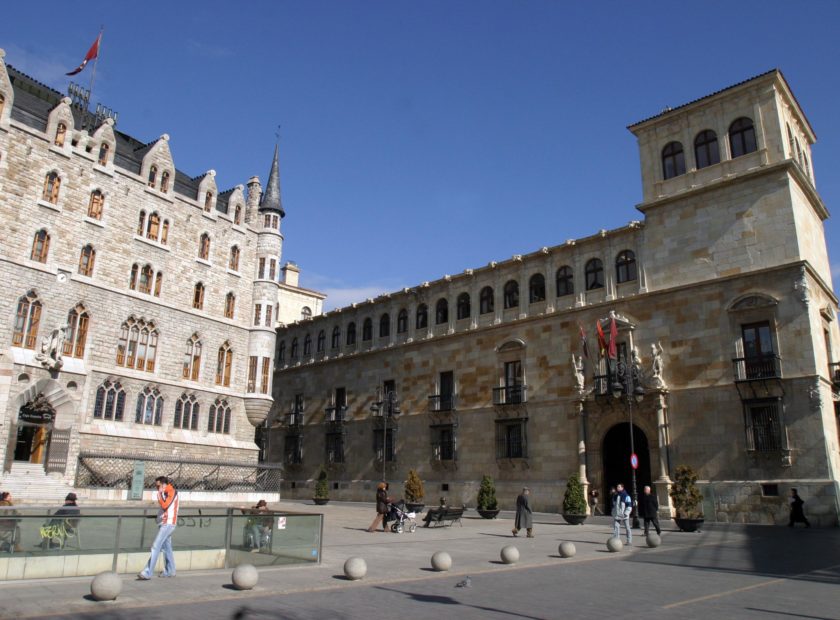Eight urban sculptures are a cultural testimony to some of the traditions, historical landmarks and famous people of León. Statues began to appear on the streets of León at the beginning of the 20th century, when the statue of Guzmán El Bueno (“The Good”) was set up in the square of the same name. Throughout the period, many pieces of sculpture were added to enhance the city and transmit a message to the citizens. Art, tradition and history imbue the most important monuments set up at strategic points and they do not go unnoticed.
The following eight urban sculptures are the cultural and historical testimony of some traditions. Milestones or well-known prominent figures for León’s city. The location of sculptures in León’s streets begins at the beginning of 20th century with the installation of the statue of Guzmán good in the square of the same name. Throughout all this time, numerous sculptural pieces have embellished the city with the idea of projecting a message to the citizen. Art, tradition and history accompany to the most emblematic monuments and are located in symbolic points of the urban studding without happening unnoticed.
Monument to Two thousand years of the City (2000):
Two years and a half of work extended until his author, Juan Carlos Ponga, saw the work finished. It is located in San Marcelo’s square and represents three of the most important stadiums of the history of the city: the Roman camp of the 1st century, the city in the 10th century when the Court was in León – and the city in the year 2000. In the latter model, the diversity of tones differentiates the different neighborhoods. The smelting, in bronze, was executed for And. He gelds and is elaborated to a scale 1/600.
Sculpture Honoring to the Builders of Cathedrals (1998):
There wanted the artist, Juan Carlos Uriarte, that glaziers, stone-cutters, blacksmiths and other officials had his(her,your) recognition in the square(seat) of the Cathedral. The sculpture rises on a labyrinthine, own(proper) base of the corners of some French cathedrals. The whole work alludes to details of the Pulchra Leonina emphasizing the silhouette that represents Nicolás Francés, author of the Gothic altarpiece of the cathedral from Leon.
Commemorative column (1968):
It is raised in the year 1968 on the occasion of the centenary XIX of the foundation of the Legio VII Gemina. Up to this moment, the archaeological remains had not revealed that the precedent of the origin of León’s city was in a previous named camp the Legio VI Victrix. For this motive, the mayor Arroyo Quiñones was approving the organization of commemorative acts of the date of the birth of the city. The column finished off with a Corinthian capital on a pedestal, rises in one of the wings of San Isidoro’s Plaza.
Las Cabezadas (1999):
Jose Luis’ Fernandez work realized in stone and bronze, it(he,she) represents one of the most significant traditions of the city from Leon. It(he,she) reflects the delivery of a candle on the part of a member of the municipal corporation to the abbot of San Isidoro. This fact takes place in gratefulness to the request of rain implored to the saint Isidoro for the people(village) from Leon in 1158. It is the act before a discussion that forms a part of the historical custom where it(he,she) defends itself if the delivery of the candle and a few hachones of wax are forum or offer.
Three Infantas (2001):
The artist salmantina, Stopped Health, recreates the image of three infantas of León’s Kingdom: the mother Sancha and the daughters Urraca and Elvira. It(he,she) produces admiration, in this creation in bronze, to three women who more contributed(paid) in the development of San Isidoro’s Basilica of León. He(she) places nine hundred years later, in a Romanesque environment, in honoring to the death of the sisters infantas, since both expired in 1101.
The Building of the Town hall (1998):
At the entry of her(it) there sedates administrative officer of León’s Town hall, in the street Ordoño II, we find another work of the artist Juan Carlos Uriarte. They are represented in bronze: The front of the building of San Marcelo’s Town hall, Juan de Rivero Rada’s work, and the document of Alfonso XI of July 6, 1345. This letter sent to León’s council, names eight ” good men ” in order that they take decisions on the city. From this written testimony guarded in León’s Municipal File, a new institution is formed(trained): the Town hall. The part in bronze lodges itself in a slab of stone in the shape of leaf(sheet) of passbook that alegoriza the step of page of the administrative municipal activity to another building, moment that took place in 1998.
Statue of Guzmán good (1900):
In 1894, the Queen Manages, Maria Cristina, he(she) was signing a Royal(Real) Decree by means of the one that was ordained to raise in León’s city a statue in honor to Alonso Perez de Guzmán ” The Good one “. Four years later of this signature(company), the sculptor Aniceto Marinas was finishing the statue of the personage to be located in Gabriel Abreu’s pedestal. The inauguration took place in the year 1900 for the members of the municipal and provincial corporation. The illustrious Guzmán had demonstrated his(her,your) loyalty to the king Sancho IV in the defense of the square(seat) of Tariff up to such a point that was capable of sacrificing his(her,your) son for the good of his(her,your) land.
Statue of the Pilgrim (1998):
It produces honoring to the Way of Santiago to his step along the city from Leon. A pilgrim rests in the perron of a cruise opposite to the front of San Marcos. It is an artistic creation of Martin of It(He,She) Coins and it was a donation of Inns on the peatonalización of the square having completed.



